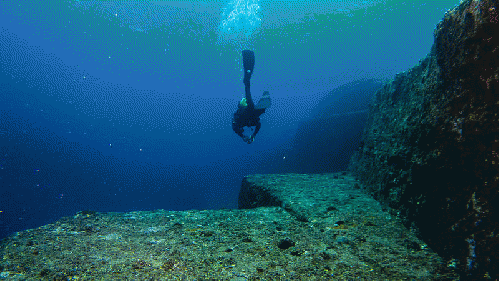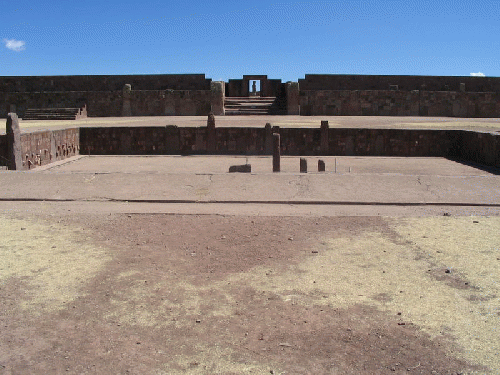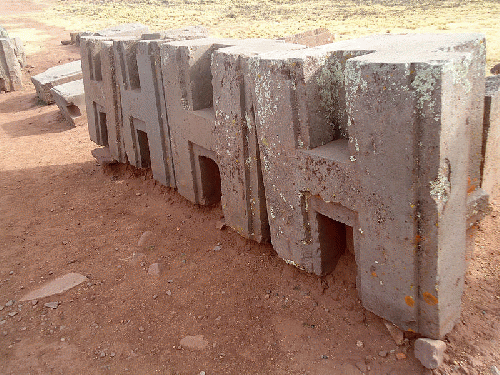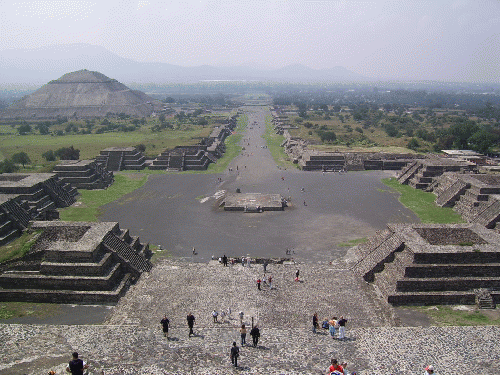This series relates a history of the Hopi as conveyed through Oswald "White Bear" Fredericks. White Bear told his story to Joseph Blumrich, who used White Bear's account to write part of his book, published in Germany in the late 1970s, "Kasskara: Und die Sieben Welten" (Kasskara and the Seven Worlds), a book which has never been available in English.
White Bear told the same story to others, of course, in the oral tradition, including my high school history teacher, Henry Denny, who was close to White Bear and his spouse, Naomi. I mention Henry in the initial report, Kasskara: Sunken Land of the Hopi Ancestors (Renamed for publication in Nexus magazine, Feb/Mar 2016)

Yonaguni, Japan
(Image by Vincent Lou from Shanghai, China, Author: Vincent Lou from Shanghai, China) Details Source DMCA
White Bear said that upon arriving on the new continent, the Kasskaran refugees' initial task was to build the first city: Taotooma (diacritical marks missing due to format restrictions), which was built at the lower part of a mountain:

Kalasasaya, a section of Tiahuanaco
(Image by (From Wikimedia) No machine-readable author provided. Anakin~commonswiki assumed (based on copyright claims). / No machine-readable source provided. Ow, Author: See Source) Details Source DMCA
Gradually the land area expanded, and the people started to migrate towards the four directions. "We could start to explore the new continent, and for this reason we used the flying shields (spaceships). Some of us had reached a sufficient rank to accompany the Kachinas during their explorations to see how the new colonies were founded," White Bear said.
Eventually there again were people who entertained their own ideas about the correct way of following the divine Creator's laws. They had left the correct path, he explained, saying that among them were people of high rank who wanted to have prestigious positions. "They began to make bad use of Tawuya (undefined). The Kachinas tried to prevent them from flying away into the universe. We were not allowed to go there as long as we had not fulfilled all of our obligations in this world. But these people falsely believed they were ready. The Creator became aware of what had happened, and after some time he came in person and took the city, raised it in the sky, turned it upside down and buried it in the ground. In all the area around it one felt the enormous air blast--the soil vibrated; it was like an earthquake. It was a disappointment for our Creator, whom we had disobeyed. After that, our people decided to disband and go in various directions. This was the first dispersion of our people on this continent.
All of that happened during the 4000 years after the clans had assembled on the new continent White Bear said. It emerged from the water looking much like it does today. Gradually the people--especially those who had remained faithful to the Creator--left the ruins of Taotooma, the first city built in the Fourth World. They wanted to separate themselves from the others in order to preserve their ancestral wisdom and cosmology as well as fulfill their sacred obligations. "They founded new colonies all over South America. They did not leave all at the same time but gradually over a long period. A Kachina was assigned to guide each group during its migration. The groups, which we call clans, had to separate in order to survive--and to successfully follow the Creator's teachings, which belonged to the divine plan. "During these migrations the Kachinas could communicate with us, and they helped us just as before," White Bear explained. "They taught us how to sow and collect the same day without waiting months for the fruits to mature."Assuming the veracity of White Bear's account, his story may advance our understanding and reveal links between underwater ruins
in the Pacific such as those at Yonaguni, Japan, the moai of Easter Island, the astonishing stone cities of South America, the pyramids of Mexico, and the kivas of Chaco Canyon, Mesa Verde and Oraibi in the southwest United States.
White Bear said that after the people had moved away from the ruins of the destroyed city, certain Kachinas were "intended" for children who had not yet been born. These children were selected to transmit the true memory of past events and noted that such events "very often arrived in our history". "The child receives the knowledge when it is still in the belly of his mother. Sometimes it is the mother who receives it so that all these thoughts can penetrate the child before the birth. For this reason the child does not need to learn later. It is only necessary to recall this knowledge which it got before its birth," White Bear explained:
"All of this happened over a several hundred years after the migration's beginning. But the teaching of the Kachinas made it possible to keep our traditions alive in memory. Often Kachinas went to the Creator at the speed of light in order to inform him of our progress on the earth. And as I've already said, some of us had acquired high ranking and had become very close to the Kachinas, which in turn enabled us to accompany them during their flights."
Migrations of the Clan of the Bear
White Bear related the history the Clan of the Bear to which his father belonged, saying he chose this clan because it was selected to serve the role of guide and leader in the Fourth World. "I learned everything from my father and his brother who knew the history of the clans and their migrations into our hemisphere because our ancestors were the chiefs of the Hopis and the Clan of the Bear since their arrival in the Fourth World," White Bear recalled. "But first I want to tell you something that was told to me by my mother. When we left the destroyed big city, the Kachinas erased the memory of all those who remained as well as their future generations. Thus all those who later lived around the ruins did not have the faintest idea what had happened before," he said.
White Bear explained that in the Third World the Bear Clan was one of the least important clans. It did not have a negative past and had not taken part in the destruction of the previous world, and for this reason itit was selected as the dominant clan in the Fourth (and current) World. "It's why the Clan of the Bear has always had a higher rank than the Clan of the Fire, which destroyed the First World, or the Clan of the Spider and the Clan of the Bow, which destroyed the Second and the Third Worlds," he said.
Because of the Clan of the Bear's status among the Hopis, a Kachina of higher rank, Eototo, was assigned to guide the people of this clan, White Bear explained, although he said Eototo was more properly referred to as a deity. Eototo stayed with them wherever they went to assure their welfare. He guided them north from South America where they encountered very harsh conditions. "The area they had to cross was terribly hot. They spent a lot of time crossing the forests and getting used to the climate; many children died at birth because of heat. Times were difficult. They wanted to seek mountains to leave this heat, but the Kachinas encouraged them to continue and protected them throughout the long journey through the jungle," White Bear recounted. "There still exists today a ceremony which recalls this protection."
After a long time they moved out of the tropical region.
The people started breathing better, the children no longer died, and the population
increased. They continued moving north as Eototo guided them towards lakes and
rivers. After many years (generations?) they arrived at an "ice barrier" near what we today call the US/Canadian border, which
prevented their further passage north. Eototo told them that this ice sheet was a door which would be opened
later for other people who would migrate towards the south.
These are the groups that anthropologists recognize as having crossed the Bering Strait. Yet the Hopis say they arrived first and came from the other the direction.
(Note: You can view every article as one long page if you sign up as an Advocate Member, or higher).






